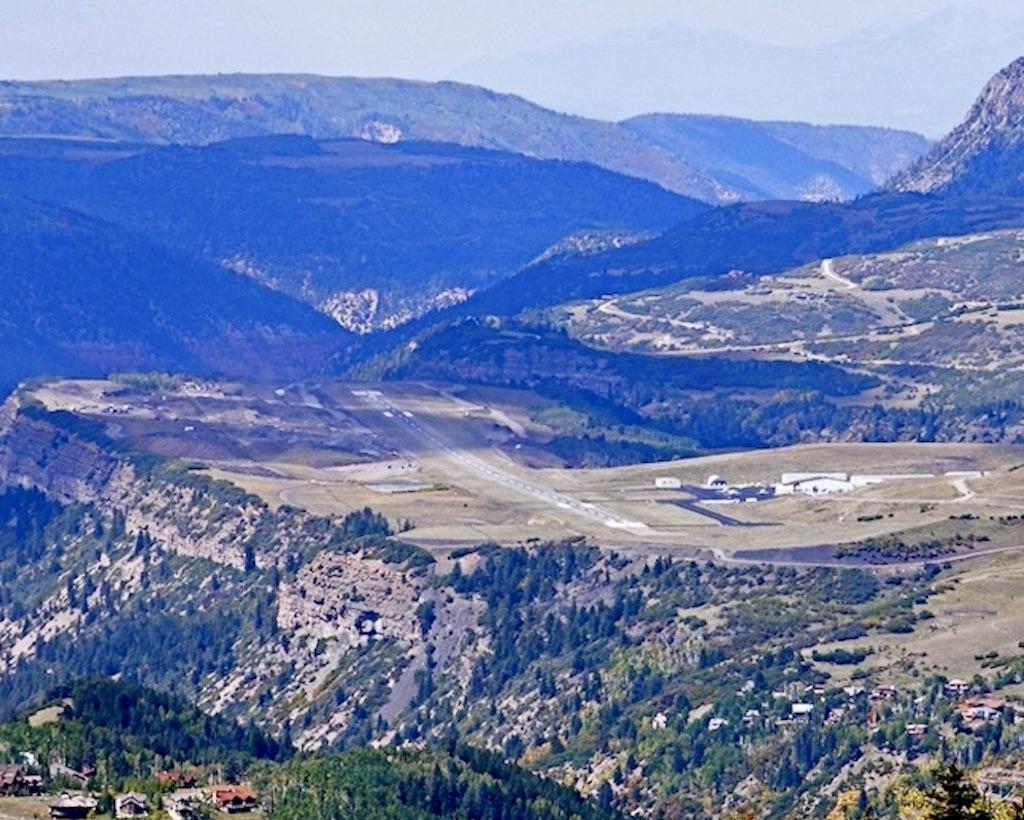
Airports confined by steep topographic terrain often will be limited to "one-way-in, one-way-out" takeoffs and departures. Shown is the topographically-confined runway at Telluride Regional Airport, looking westward toward the lower terrain.
Several of business aviation’s most desirable destinations have limitations that restrict flight operations. A prime example is Aspen-Pitkin County Airport (ASE) in Colorado.
The instrument approach procedures at ASE are not authorized at night because areas of unlighted terrain conflict with traffic patterns and circling descent maneuvers near the airport. This issue was highlighted in the investigation of the fatal crash of an Avjet Gulfstream III there on March 29, 2001, while conducting a charter flight. The two pilots, a flight attendant and 15 passengers were killed when the jet crashed into sloping terrain about 2,400 ft. short of the runway threshold.
The NTSB found that although the accident occurred only 7 min. after the beginning of official night, the mountainous terrain created twilight and nighttime conditions much earlier.
The safety board calculated that the sun had set below the mountainous terrain about 25 min. before the official sunset time and that evening civil twilight ended about 6:30 p.m. rather than 6:55 p.m. Also, the shadow for the ridge immediately to the west of the accident site would have crossed the site 79 min. earlier than official sunset. As a result, the dark condition significantly degraded the flight crew’s ability to see and safely avoid terrain while making the visual transition from the instrument approach to an intended landing.
Unfortunately, the chain of events can be traced back to passengers being delayed in infamous Los Angeles traffic, which led to a later-than-planned departure from Los Angeles International Airport. Though the pilots tried to communicate the necessity to depart on time to meet the nighttime restriction at ASE, the investigation revealed numerous instances before and during the flight when the charter customer placed inordinate pressures on the aircraft operator and its pilots.
BizAv Airport Restrictions
Key airports serving business aviation have strident noise restrictions. ASE restricts operations by Stage II/III aircraft from 0700 MST to 30 min. after sunset. Stage III aircraft can operate only from 30 min. after sunset to 2300 MST. No departures are allowed after 2230 local time except for aeromedical flights.
Pilots on instrument flight rules (IFR) flight plans from Santa Monica Airport in California must obtain approval from air traffic control prior to starting their engines to minimize ground delays between engine-start and takeoff. Pilots are requested to limit auxiliary power unit (APU) use to 30 min. A mandatory curfew applies to engine starts between 11 p.m. to 7 a.m. on weekdays, and from 11 p.m. to 8 a.m. on weekends.
An airport’s availability can also be affected by a large sporting or political event leading to the creation of a temporary flight restriction for non-air carrier traffic. The Formula One Las Vegas Grand Prix requires prior permission. Slot reservations have been required in past years for Colorado ski resort airports during the holidays. The Allen & Company Sun Valley Conference has caused faraway ground stops due to the convergence of business jets at Friedman Memorial Airport in Hailey, Idaho.
Even if you have an IFR slot reservation or these events, you are not guaranteed there will be ramp space for your aircraft. If your arrival or departure is outside of a fixed-base operator's (FBO) hours of normal operations, a proactive phone call can save you the embarrassment and aggravation of arriving at a closed FBO. Similarly, smaller FBOs may not be able to procure catering on a 24/7 basis. Fancy catering that would be available at large business aviation FBOs is not likely to be an option at smaller ones.
Owner-Induced Delays
How often have you planned the weight and balance for a flight only to have the client show up with an extra guest? Naturally, the client still expects an on-time departure, right? This requires an entire reiteration of the weight and balance and re-computation of the aircraft’s performance. It might require having the new person’s name submitted to your company to check against security lists.
If the aircraft will be too heavy with the fuel load to meet the takeoff and climb requirements, it may be necessary to burn off fuel if an FBO is not able to offload it from the aircraft. This has led to lapses of judgment by flight crews who thought that dragging the brakes during a prolonged taxi would help to burn off excessive fuel. In some cases, the practice led to the fuse plugs melting after the wheel assemblies heated, resulting in the aircraft sitting with flat tires in the middle of the taxiway.
The sage expression “Prior Planning Prevents Poor Performance” needs to be a core value in a flight department. Anticipating events such as worsening weather, airport limitations or aircraft components nearing the end of their usable life can help a department avoid undesirable delays. This requires proactive communications between dispatchers, pilots and maintenance technicians.
To read Factors That Affect Aircraft Availability, Part 1, click here.
To read Factors That Affect Aircraft Availability, Part 2, click here.





